Target Bundle
How Does Target Dominate the Retail Game?
Target, the retail giant, has mastered the art of captivating consumers with its unique "cheap chic" approach. From its humble beginnings as a discount store, Target has evolved into a retail powerhouse, consistently outperforming competitors. Understanding Target's sales and marketing strategies is key to unlocking its success.
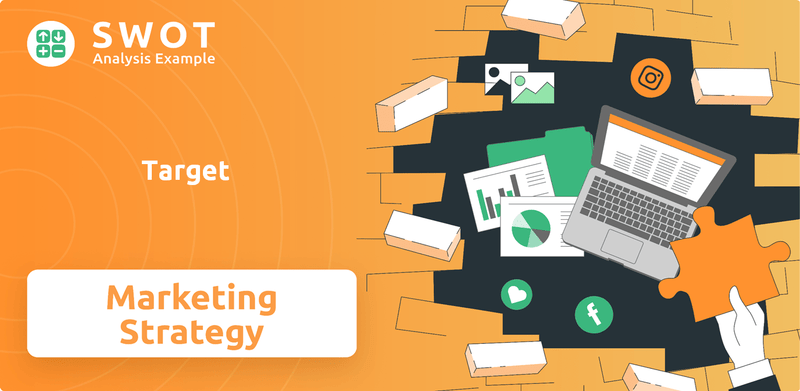
This deep dive into the Target SWOT Analysis will dissect the company's sales strategy, examining how it reaches its target market through various channels. We'll uncover the marketing strategy behind its brand awareness and revenue generation, analyzing its digital marketing efforts and customer relationship management. Explore how Target's strategic plans, including its ambitious business goals, are shaping its future marketing plans and competitive advantage in the retail landscape, alongside the sales strategy implementation steps.
How Does Target Reach Its Customers?
The sales strategy of the Target company revolves around a robust omnichannel approach, blending both online and offline channels to cater to a wide customer base. This integrated strategy focuses on providing a seamless shopping experience, whether customers choose to shop in-store, online, or through specialized fulfillment services. The goal is to enhance customer convenience and drive revenue generation through various touchpoints.
The marketing strategy complements the sales strategy by focusing on brand awareness and customer engagement. The company leverages its physical stores, e-commerce platforms, and partnerships to reach its target market. This multi-faceted approach aims to create a cohesive brand experience, encouraging customer loyalty and repeat purchases. The company's business goals are supported by these integrated sales and marketing efforts.
The company's sales channels are designed to maximize accessibility and convenience for its customers. This strategy includes a widespread physical presence, a user-friendly e-commerce platform, and efficient fulfillment options. The company's commitment to providing a seamless shopping experience is evident across all its sales channels, contributing to its competitive advantage in the retail market.
The company operates an extensive network of physical retail stores, serving as a primary sales channel. As of February 2025, there are 1,978 stores across the United States. The strategic placement of these stores ensures that approximately 75% of U.S. consumers live within 10 miles of a store, making them highly accessible.
The company's e-commerce presence includes Target.com and the Target app, which are key platforms for online shopping. These platforms provide customers with a convenient way to browse and purchase products from anywhere. The company continues to invest in its digital marketing efforts to enhance the online shopping experience.
Specialized fulfillment services, such as Drive Up and Order Pickup, are integral to the company's sales strategy. These services leverage the company's store network to provide same-day delivery and pickup options. In the fourth quarter of 2024, digital comparable sales grew by 8.7%, with same-day delivery growing by more than 25%.
Target Plus is expanding, with a goal to increase sales from approximately $1 billion in 2024 to over $5 billion by 2030. Partnerships with brands like Disney, Levi's, Apple, and Ulta Beauty create exclusive product lines and shop-in-shop experiences. The partnership with Shopify, announced in June 2024, expands the assortment on Target Plus.
The company's sales strategy emphasizes integrating its sales channels to provide a seamless customer experience. Stores fulfilled more than 96% of total sales in 2024, demonstrating their crucial role in both in-store and digital transactions. This integration supports the company's customer relationship management efforts and drives overall sales performance.
- The company's commitment to omnichannel integration is a key aspect of its sales strategy for retail.
- The company's e-commerce platforms and fulfillment services are designed to enhance customer convenience.
- Partnerships and exclusive distribution deals contribute significantly to the company's growth and market share.
- The company's digital marketing efforts and sales strategy implementation steps are focused on driving revenue.
Target SWOT Analysis
- Complete SWOT Breakdown
- Fully Customizable
- Editable in Excel & Word
- Professional Formatting
- Investor-Ready Format
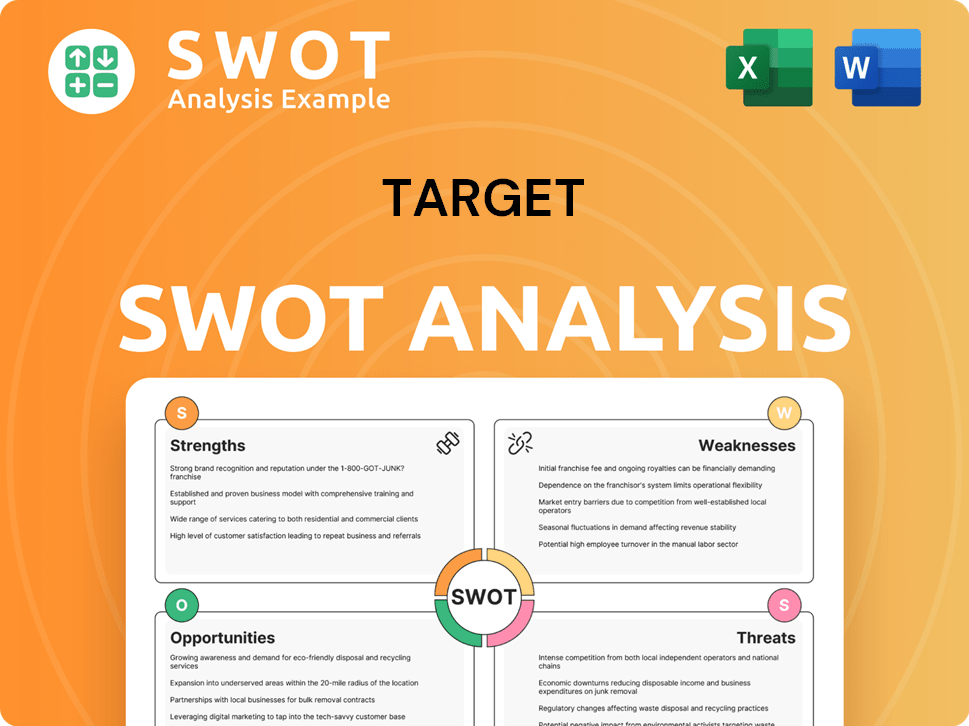
What Marketing Tactics Does Target Use?
The marketing tactics employed by the company are multifaceted, encompassing both digital and traditional channels to enhance brand visibility, attract potential customers, and boost sales. In fiscal year 2023, which concluded in February 2024, the company allocated $1.4 billion towards net advertising costs, reflecting its significant investment in marketing initiatives.
The company's approach to marketing is data-driven, with a focus on personalization and customer engagement across all platforms. This strategy involves leveraging advanced analytics to tailor experiences and deliver relevant promotions, ultimately aiming to increase customer spending and foster brand loyalty. The integration of digital and physical experiences, such as the Target Circle 360 membership program, further exemplifies this comprehensive approach.
The company's marketing strategy is designed to drive revenue generation and achieve its business goals by effectively targeting its market and implementing a robust sales strategy. This includes a blend of digital and traditional methods, ensuring a broad reach and personalized customer experiences.
Digital tactics are central to the company's marketing mix, incorporating content marketing, SEO, paid advertising, and social media strategies. The company's in-house media company, Roundel, is a key player in digital advertising. Roundel's revenue from advertising rose approximately 24% year over year to $649 million in 2024.
The company is innovating with AI-powered solutions to refine product recommendations, optimize search results, and integrate with social media trends. This allows for a more personalized and efficient customer experience. The use of AI enhances the overall effectiveness of its marketing efforts.
The company's loyalty program, Target Circle, has over 100 million members, playing a crucial role in data-driven marketing. The program offers personalized deals and rewards based on customer behavior. Personalized marketing can increase customer spending by 30%.
Traditional media, including TV, radio, and print, remains part of the company's strategy to reach a wider audience. This is combined with in-store events to create a comprehensive marketing approach. The company uses data analytics to ensure relevant promotions across all channels.
The company is continuously testing and optimizing its omnichannel strategy based on customer data and feedback. This includes integrating digital and physical experiences, like the Target Circle 360 membership program. This program offers benefits such as unlimited free same-day delivery.
The company introduced a generative AI tool called Store Companion in June 2024, deployed across its nearly 2,000 stores. This tool assists team members with real-time answers, enhancing customer service. This tool improves the customer experience.
The company's marketing strategy involves a blend of digital and traditional methods, all supported by data analytics and personalization. This approach is designed to enhance brand awareness, drive sales, and foster customer loyalty. For more insights, see the Growth Strategy of Target.
- Content Marketing and SEO: Creating valuable content and optimizing for search engines.
- Paid Advertising: Utilizing various platforms to reach a wider audience.
- Email Marketing: Sending targeted promotions and updates to customers.
- Influencer Partnerships: Collaborating with influencers to promote products.
- Social Media Engagement: Building a strong presence on social media platforms.
Target PESTLE Analysis
- Covers All 6 PESTLE Categories
- No Research Needed – Save Hours of Work
- Built by Experts, Trusted by Consultants
- Instant Download, Ready to Use
- 100% Editable, Fully Customizable
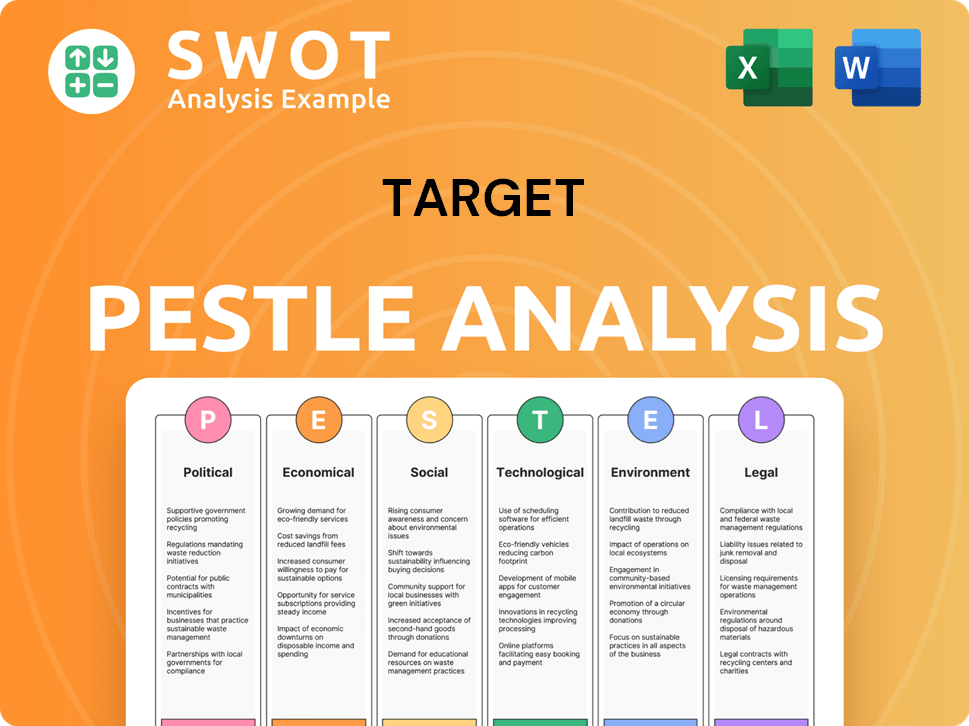
How Is Target Positioned in the Market?
The brand positioning of the Target company is centered on 'cheap chic,' offering stylish and affordable merchandise. This strategy differentiates it from competitors, appealing to a wide consumer base seeking quality and value. The company's core message, 'Expect More. Pay Less,' encapsulates its commitment to delivering elevated products at competitive prices, driving its sales strategy.
Target's visual identity is immediately recognizable through its iconic bullseye logo, symbolizing precision and customer focus. The company's marketing and communications use an accessible, friendly, and aspirational tone, aiming to create a pleasant shopping experience. This approach is designed to make shopping 'easy, affordable, and joy-filled,' supporting its marketing strategy.
To understand how the company positions itself, it's helpful to look at its target market and overall approach. Read more about it here: Target Market of Target.
Target's diverse product range, including apparel, home goods, electronics, and groceries, positions it as a one-stop-shop. This broad offering caters to various consumer needs, supporting its sales strategy for retail. The company's ability to provide a wide array of products helps drive revenue generation.
The success of Target's private label brands, like Cat & Jack and Good & Gather, significantly contributes to its brand positioning. These brands offer high-quality items at competitive prices, fostering customer loyalty and contributing to the company's profitability. These owned brands are a key part of its marketing strategy for brand awareness.
Maintaining brand consistency across all channels, from physical stores to digital platforms, ensures a unified customer experience. This unified approach strengthens brand recognition and supports its digital marketing efforts. Consistent branding is essential for achieving business goals.
Partnerships with popular brands and designers, such as Disney and Levi's, enhance Target's appeal and offer exclusive collections. These collaborations boost its cachet and attract a broader customer base, contributing to its marketing campaign analysis. These partnerships also support the sales strategy for product launch.
Target's commitment to corporate social responsibility (CSR) and sustainability, through its 'Target Forward' strategy, enhances its brand perception. This strategy aims to create inclusive, sustainable brands and experiences, supporting its long-term vision. This focus on sustainability is a key element of its future marketing plans.
In 2024, the company introduced new owned brands like 'dealworthy' for low-price essentials and 'Gigglescape' for toys, while also refreshing existing ones like 'Auden' and 'up&up'. This expansion of owned brands strengthens its market position and offers diverse product choices. These brands are a key part of its sales strategy implementation steps.
Target focuses on making shopping easy, affordable, and enjoyable for its customers. This approach includes user-friendly online platforms and in-store experiences. This focus on customer experience is a critical part of its customer relationship management.
The company invests heavily in digital marketing to reach its target market. This includes social media campaigns, targeted advertising, and e-commerce initiatives. These efforts are part of its marketing strategy for e-commerce.
Key performance indicators (KPIs) such as sales growth, customer acquisition cost, and customer lifetime value are used to measure the effectiveness of its sales strategy. These metrics help in assessing the sales strategy performance metrics. In Q1 2024, Target's comparable sales decreased by 3.3%, showing areas for improvement.
The marketing strategy budget allocation is carefully planned across various channels, including digital advertising, in-store promotions, and partnerships. This strategic allocation ensures efficient use of resources and supports its marketing strategy budget allocation. In 2023, Target's marketing expenses were approximately $1.7 billion.
Target Business Model Canvas
- Complete 9-Block Business Model Canvas
- Effortlessly Communicate Your Business Strategy
- Investor-Ready BMC Format
- 100% Editable and Customizable
- Clear and Structured Layout
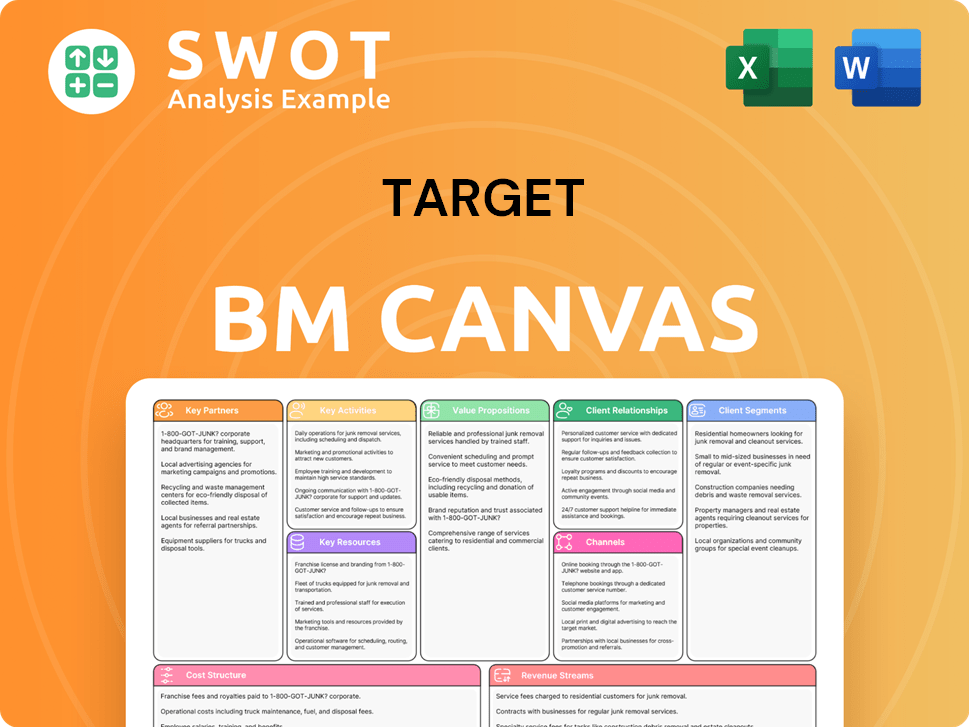
What Are Target’s Most Notable Campaigns?
The sales and marketing strategies of the Target company involve several key campaigns aimed at boosting sales, improving customer engagement, and strengthening its brand identity. These initiatives are continuously evolving to meet changing market demands and consumer preferences. The company's approach is multi-faceted, incorporating digital and in-store experiences, strategic partnerships, and a focus on owned brands.
A primary focus of the Target company is enhancing its omnichannel experience, including services like Drive Up, Order Pickup, and same-day delivery. These efforts are supported by the company's loyalty program, Target Circle 360. Furthermore, the expansion and promotion of owned brands and strategic partnerships are crucial for attracting diverse customer segments. Target also emphasizes sustainability through its 'Target Forward' strategy, which includes initiatives like the Denim Take-Back Event and the Car Seat Trade-in Program.
The strategic direction announced in March 2025, which targets over $15 billion in sales growth by 2030, represents a significant overarching campaign. This plan includes major investments in stores, supply chain, and technology, as well as the expansion of the Target Plus marketplace. These initiatives are designed to enhance the company's competitive advantage and achieve its business goals.
Target's commitment to omnichannel services, such as Drive Up, Order Pickup, and same-day delivery, is a key component of its sales strategy for retail. In Q4 2024, same-day delivery, powered by Target Circle 360, experienced over 25% growth. Digital comparable sales increased by 8.7% during the same period. These efforts aim to improve customer experience and drive revenue generation.
The company continuously launches and refreshes its owned brands, such as 'dealworthy' and 'Gigglescape,' to offer value and newness to its target market. Collaborations with brands like Champion and Disney, and shop-in-shops with Ulta Beauty and Apple, boost brand visibility. The limited-time partnership with Kate Spade in Q1 2025 was its strongest designer collaboration in the last decade. These partnerships are a crucial part of the marketing strategy.
Target's strategic plan, announced in March 2025, outlines significant investments to achieve over $15 billion in sales growth by 2030. The plan includes $4 billion to $5 billion in investments in stores, supply chain, and technology in 2025. The Target Plus marketplace is projected to grow from $1 billion in 2024 to over $5 billion by 2030, supported by partnerships like the one with Shopify announced in June 2024.
Target's 'Target Forward' strategy includes initiatives like the Denim Take-Back Event in July 2024 and the Car Seat Trade-in Program. These programs serve as brand-building campaigns, showcasing the company's commitment to environmental responsibility and enhancing its public image. These initiatives are part of the marketing strategy for brand awareness.
These campaigns and strategies are integral to the overall sales and marketing efforts of the Target company. The company's digital marketing efforts and customer relationship management are continuously evolving to meet the changing needs of its target market. The focus on same-day services and the expansion of the Target Plus marketplace are examples of the company's future marketing plans.
- Focus on Omnichannel Experience: Enhancing Drive Up, Order Pickup, and same-day delivery services.
- Expansion of Owned Brands: Launching and refreshing private labels to offer value and newness.
- Strategic Partnerships: Collaborations with brands like Champion, Disney, and Ulta Beauty.
- Strategic Growth Plan: Investing in stores, supply chain, and technology to achieve significant sales growth.
- Sustainability Initiatives: 'Target Forward' strategy, including programs like the Denim Take-Back Event.
For more information about the company's history and evolution, you can read a brief history of Target.
Target Porter's Five Forces Analysis
- Covers All 5 Competitive Forces in Detail
- Structured for Consultants, Students, and Founders
- 100% Editable in Microsoft Word & Excel
- Instant Digital Download – Use Immediately
- Compatible with Mac & PC – Fully Unlocked
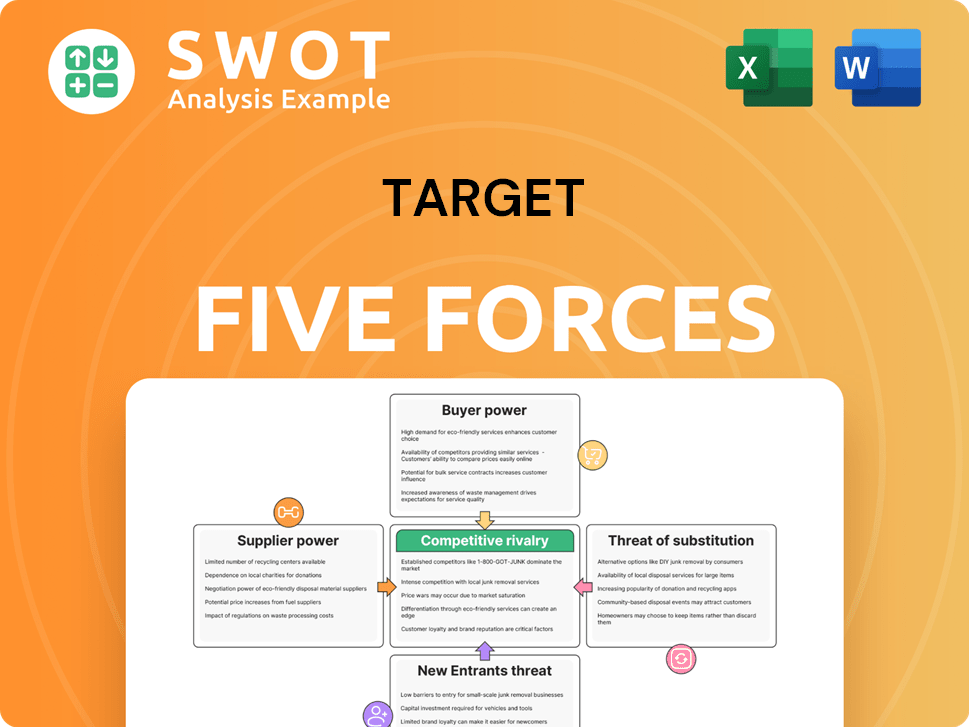
Related Blogs
- What are Mission Vision & Core Values of Target Company?
- What is Competitive Landscape of Target Company?
- What is Growth Strategy and Future Prospects of Target Company?
- How Does Target Company Work?
- What is Brief History of Target Company?
- Who Owns Target Company?
- What is Customer Demographics and Target Market of Target Company?
Disclaimer
All information, articles, and product details provided on this website are for general informational and educational purposes only. We do not claim any ownership over, nor do we intend to infringe upon, any trademarks, copyrights, logos, brand names, or other intellectual property mentioned or depicted on this site. Such intellectual property remains the property of its respective owners, and any references here are made solely for identification or informational purposes, without implying any affiliation, endorsement, or partnership.
We make no representations or warranties, express or implied, regarding the accuracy, completeness, or suitability of any content or products presented. Nothing on this website should be construed as legal, tax, investment, financial, medical, or other professional advice. In addition, no part of this site—including articles or product references—constitutes a solicitation, recommendation, endorsement, advertisement, or offer to buy or sell any securities, franchises, or other financial instruments, particularly in jurisdictions where such activity would be unlawful.
All content is of a general nature and may not address the specific circumstances of any individual or entity. It is not a substitute for professional advice or services. Any actions you take based on the information provided here are strictly at your own risk. You accept full responsibility for any decisions or outcomes arising from your use of this website and agree to release us from any liability in connection with your use of, or reliance upon, the content or products found herein.